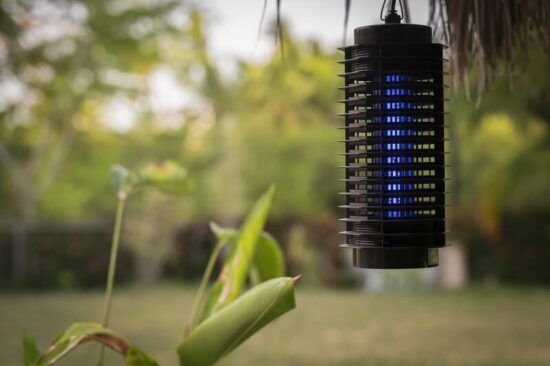Bug zappers are a favorite tool in the pest control arsenal of homeowners everywhere. Not only are they hands-off, but there’s something so satisfying about frying pesky little insects!
But do bug zappers work during the daytime? Read this guide to find out.
Table of Contents
What Are Bug Zappers?
Bug zappers are a unique pest control device with a long and colorful history.
They look pretty high-tech by today’s standards. They’re certainly a step above citronella candles and other passive bug control techniques, producing audible “zaps” to kill bugs in mere seconds. But despite the technology seeming complex, these devices have been around for more than 100 years!
The concept is simple:
Bug zappers attract bugs using light. When they get close enough, an electric charge electrocutes the bug and kills it instantly.
The “zap” sound you hear is a bug getting shocked and dying.
Of course, the design has evolved significantly since the first release over a century ago. Nowadays, you have bug zappers with numerous features, sleek designs, and extras to make your bug-fighting efforts more successful.
These simple devices are an indispensable tool to have in your bug-fighting arsenal. They’re quick and surprisingly effective.
Not only that, but they work to kill a wide range of insects. Most people use them to kill flies and mosquitos, but they also work to eradicate:
- Moths
- Lightning bugs
- Beetles
- Spiders
- Grasshoppers
- Wasps
- Stink bugs
Any bug attracted to light can succumb to the allure of a bug zapper. Roaches and other light-sensitive insects will steer clear of these gadgets. But any insect that wanders towards the light during the day and night will be toast.
How They Work
To understand whether bug zappers work during the day or not, you must have a good grasp on how these gadgets operate.
Designs can vary from one brand to another. But they all have a few key components.
First, there’s the housing. Also referred to as a case, this component is what holds everything together. It’s the part you interact with most when handing the bug zapper and gives the device a clean look.
You might not think housing matters very much, but it plays a big part in safety. High-quality zappers are usually made of thick plastic that insulates the dangerous bits while adding durability to avoid accidents. Ideally, you want a zapper that’s tough enough to handle falls, ensuring that no damage will expose the other components.
Next, we have the light. This central component is the part that attracts bugs.
You might see fluorescent bulbs or neon tubes acting as the light source. Most brands use a specially-made bulb that purposefully fits the housing. Either way, the light usually isn’t enough to act as a solitary light source.
It’s bright enough for the bugs but won’t replace a standard lamp.
The light is the most critical piece of the puzzle, and this is likely why people wonder if bug zappers work during the daytime. Without it, the zapper wouldn’t work at all. You see, this light isn’t your regular LED or incandescent.
It produces UVA rays like the sun. Infrared light is something we humans can’t see without special filters and equipment, but bugs can see it surprisingly well.
Insects view the world a little differently than we do. The UVA rays are a powerful attractor, and many insects are instantly drawn to any lamp that produces them. That’s not the case with every outdoor bug. For example, mosquitoes aren’t interested in the UVA rays. The same goes for roaches and other pests.
But, in the case of mosquitos and flying pests, they still might go near the lamp due to heat or exploration.
As the bug gets closer, the third critical component jumps into action. We’re talking about the electrical components.
Here’s where the true ingenuity of bug zappers comes in. Some people assume that it’s the bulb itself that kills the insects, but that’s not the case.
Instead, it’s an array of wires and mesh. Usually, bug zappers have two wire grids or screens. These grids are akin to chicken wire. They keep kids’ hands away from the electrical components, but they offer enough room for the bug to fly through as they move towards the light.
Little does the bug know that a transformer electrifies the wire mesh. It creates a high-voltage charge.
When the lamp is on, and no insects are nearby, the electrically charged wire grids don’t do anything. They’re quiet and don’t cause any harm.
But that all changes when a bug enters the scene. As the insect flies through the grid and towards the light, they complete the electrical circuit. In an instance, the high-voltage current flows from the wire and through the bug.
The bug quickly vaporizes, and all you notice is that distinct “zap” sound!
Depending on the model of the zapper, you might also have a bug-catching tray. This component catches any unlucky bug that dies due to the electric shock. Smaller bugs vaporize quickly, but others might die and fall into the catch.
Always empty it frequently to keep your zapper in good shape!
Do Bug Zappers Work In The Daytime?
You would think that a device relying on the allure of light wouldn’t work in the daytime. However, you’d be wrong!
Bug zappers work during the day. And while they’re not always the ideal solution, you can take advantage of these devices in the right conditions.
The biggest obstacle is light. Insects that are drawn toward light sources can still see the zapper during the day. But the problem is that many other lights are in the same area.
Bugs are simple creatures. They get easily distracted and don’t always go where you want them to. While they might see the zapper and be interested in exploring it, light from the sun can pull their focus.
The same goes for reflections off windows, brightly colored and lit objects, and anything else that might capture their attention.
Bug zappers can work during the daytime, but you must use them a little more strategically to get the best results.
How To Use A Bug Zapper During The Day
If you’re considering using your bug zapper during the day, you’ll need to be mindful of placement.
Bug zappers are so effective at night because they’re often the only source of light bugs see. Think of it as a lighthouse beacon in the middle of a dark sea. That slight glow of light is enough to attract any bug.
But during the day? Multiple sources of light can draw bugs in!
If you want to use a zapper during the day, you must try and control the light in the immediate area.
Inside your home, that’s pretty easy. All you have to do is draw the blinds, use the curtains, and cut off as much natural light in the room as possible. It doesn’t have to be pitch black. Bug zappers can work well in dimly lit spaces.
However, you must ensure that there aren’t any beams of light or strong illumination sources near the device. Make sure that you can see the light inside well.
What about outside?
Of course, using a bug zapper in an open space filled with daylight isn’t going to provide the results you want. If you’re trying to enjoy time in the sun, you’ll need to turn to other pest control methods to get rid of bugs. Zappers won’t help you in those scenarios.
But if you have some shade coverage, you might have the protection you need to make your bug zapper work during the day. Place the device under as much shade as you can get. That could be under the canopy of a large tree or a thick umbrella with zero light leaks.
The goal is to cast as much of a dark shadow onto the device as possible. If you manage that, you’ll be surprised by how many bugs the zapper can take out even in the middle of the day!
Is It More Effective During The Day Or At Night?
Because these devices operate on the principles of light attraction, the answer to this question is here.
While bug zappers work during the day, they are more effective at night. You can still get decent efficiency with careful placement and planning during the day. But it’s no match for nighttime efficiency.
Bugs flock to any source of light they find during the night. They move through a sea of darkness and naturally gravitate towards any splash of light they can find. That’s why so many bugs accumulate onto porch lights, solar lamps, and other accent lights you have on your property.
At night, the zapper is usually the only lit object they see. Despite the constant snaps and zaps you hear, bugs will continue to move towards the light.
That’s not the case during the day. The insect “death count” is much smaller due to the many light sources available. Bugs get distracted and move elsewhere, leaving the zapper only to kill the unlucky few.
Conclusion
Bug zappers work during the daytime, but it’s not exactly the most efficient way to use them. With that being said, there’s really no harm in giving them a shot!
If you have questions about ways you can make these zappers work during the day, send them to us.


